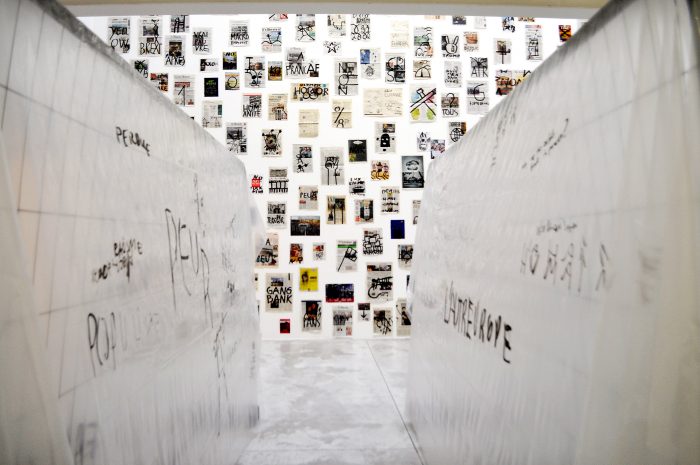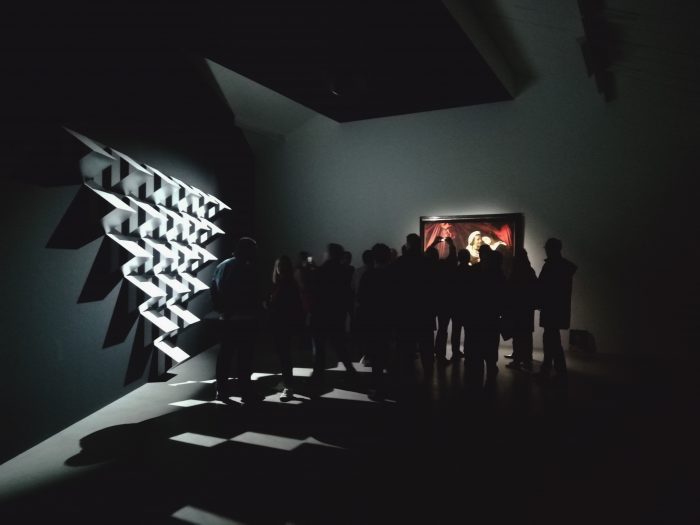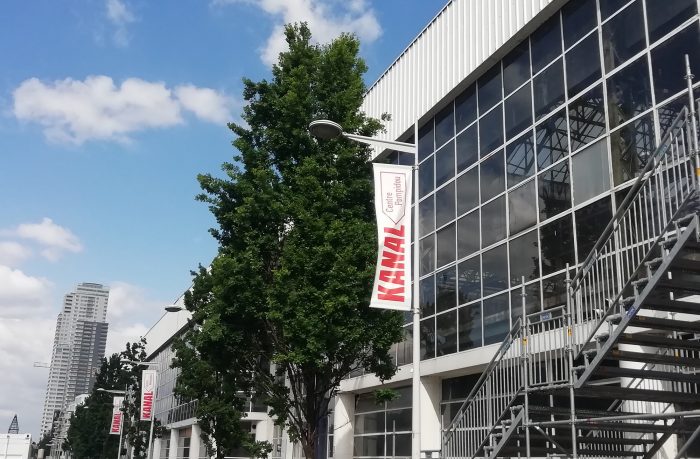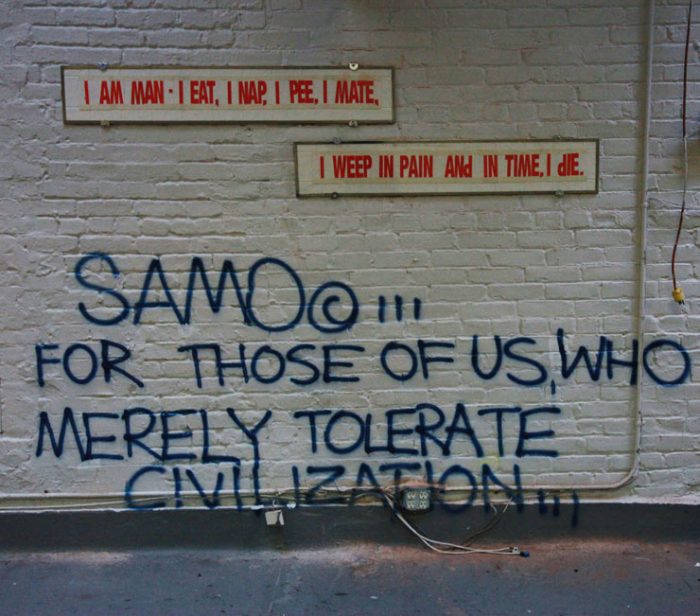Possibilities of coexistence. Kiasma, Helsinki | for ARTA Magazine
Posted by Raluca Turcanasu on / 0 Comments
„Coexistence”
KIASMA, Helsinki
From 26.4.2019 to 1.3.2020
Curators: Saara Hacklin, Kati Kivinen, Satu Oksanen
For Revista ARTA, print, #42-43, available for purchase here.
In the global coronavirus pandemic context in which we find ourselves, I find it timely to revisit – mentally and digitally – „Coexistence”, an exhibition at Kiasma, one of the Contemporary Art Museums in Helsinki, part of the Finnish National Gallery. The experience of revisiting from a distance – physical, temporal – is epistemologically essential, the meanings and multiplicities decant and, thus, one can discern more than the sum of the parts – just like Didi-Huberman would discover and go in the depth of details not on the spot, facing the physical painting, but mediated, lookig later at the photos he had made.
Among others, the coronavirus reminds us – simply, frightening, piously and with the dread of the non-human, of Gaia – of the principle of quantic inseparability, a basic principle in quantic physics, through which two entangled particles behave as a singular physical object. „In nature, everyone feeds on everyone else” – this is a reminder from Kati Roover’s work that also gives the title of the exhibition – in a frugal abundance in which symbiosis is the governing law. “Coexistence” is the primary state. “Coexistence” is a manifesto for a “multiple being, with many voices, eyes, roots and stories”[1], a manifesto to rethink the culture made by people for people, in which multiple worlds are reduced to one, a manifesto for a multidimensional presence.
A reflection I did from inside Kiasma
At Kiasma, I have discovered a contemporary art space genuinely wishing to redefine art and culture in relation to nature and spirituality. This is what the gallery sets out to do, through its very name: Kiasma is the Finnish for “chiasma”: the crossing of nerves or tendons within the optic nerve fibres, the intertwining of two chromatids or the thread-like strands of a chromosome. The curators, Saara Hacklin, Kati Kivinen and Satu Oksanen, propose an intersectional exhibition, which, sometimes with finesse and grace, other times with irony, indicates the inseparability of nature and culture, this false dichotomy inherrited from the Western thought history. Split today between „the imperative to isolate and our global interdependency”(Butler[2]) and also our molecular one, we are only left to explore and reimagine, for humankind, an existence in quantic multiplicity, a becoming-existence (Deleuze). However, in the anthropocene – Jason Moore prefers to call it „capitalocen”, to stress capital accumulation as a central node of reckless extractions and of the commodification of the non-human – humanity has warded off the benefic symbiose modalities, that is the non-parasitic ones. We ought to relearn symbiosis in commensalism (the interaction in which one species benefits and the other neither benefits nor is harmed) or in mutualism (the interaction from which both species benefit).

Outi Pieski, Our Land, Our Running Colours, 2016, © Finnish National Gallery / Kiasma
„Coexistence”, Kati Roover’s work[3], criticises these binary modes of thinking and invites us to a comparrison with the Amazonian rainforest, as a multiple being: „how can we think with this place? How can we reconsider the mutual human centrality and reimagine the world and its interspecies relations differently?”. Historically socialized in the centrality of whiteness, the exercise of looking through the eyes of a lichen or those of an ant is as difficult as through the eyes of a contemporary slave. The video seeks to bring forward, in a poetic posthumanist discourse overlapping images from the Amazonian jungle, the zones of indiscernability of natural life, which are not object of the contemporary pixel perfect world vision. Only that in this retina ready vision we cannot see the demodex, a mite that lives peacefully on our faces in commensalism – represented in Alma Heikkilä’s work „primary sensory interface with the external world” from 2017, a diptych in which on one side there is a human face and, on the other, a demodex – and even less the microbiom inside.
The work can be regarded together with „Genesis According to Parrots”[4], a video installation by Sergio Vega (2002-2005), in which, among palm trees, we can see and hear parrots retelling the Genesis in their own language, „subtitled”. The camera uses the demiurge angle that sees and hears everything, to put under ironic scrutiny extreme individualism, binary thinking („wet and wild is the precognitive frontier between nature & culture”), colonial europenism („and the Lord took the man and put him in the garden of Eden to till & watch over until the Europeans would arrive”) as well as creationist institutionalised gender and specie domination.

Capture from Sergio Vega’s video work “Genesis according to parrots”, available here: https://vimeo.com/156155494
The exhibition takes us from one artistic medium to another at different non-humans: from organic elements (Charlotta Östlund, „Cup, Bouquet, Moulting”– eco-sculpture – 2016-2017) to plankton, fish, mussels and other marine organisms (Enia Vainio, „un”, 2019 – painting on textile, commissioned by Kiasma), to horses (Fanni Niemi-Junkola, „Protection”, 2016 – video) or artificial intelligence (Maija Tammi, „One of them is human”, 2018 – series of 4 photographic portraits in which only one is human). „Protection”, Fanni Niemi’s video work, traces a hand petting and massaging a black horse, to talk about the protective gesture as a bilateral event, in which, although the human seems to be protecting the horse, the act of caressing the animal (and also of watching this act unfold, through mirror neurons) brings spiritual relief to the human, too. Simply and innocently, the work presents, in fact a state of becoming localised somewhere between the physical and the mental, a quantic state, both physic and mystique.
From the genesis, through an arch through time (Alan Sonfist, „ARC of Finland VIII/XX”, 1996) we find a letter and a pouch of seeds. Preoccupied with pollution and the threat of cutting down forests, Sonfist sent out 100 such packages to 100 museums in the entire world, to invite them to rather celebrate nature than human accomplishments and to create a bridge in time through these seeds of the future. We then advance to death on the conveyor belt: „Community”, a work from 2017 by Terike Haapoja is a video installation on 5 channels that presents the gradual cooling of five animal carcasses, projected in natural size. Even though a vast number of people consider themselves animal lovers, the majority of domesticated animals end up on a plate. Hence, Haapoja’s work becomes, on one hand, a manifesto for understanding the human as an ecosystem an as part of nature, not as an individual instance with trophic superiority; on the other hand, it serves as memento mori: the spectators of those deaths, here transformed into art objects, will have, sooner or later, the same bodily decay. (However, maybe if we hadn’t been invading, again and again, the bodies of others, humans and non-humans, we wouldn’t be, in our turn, invaded by lethal micro-parasites).
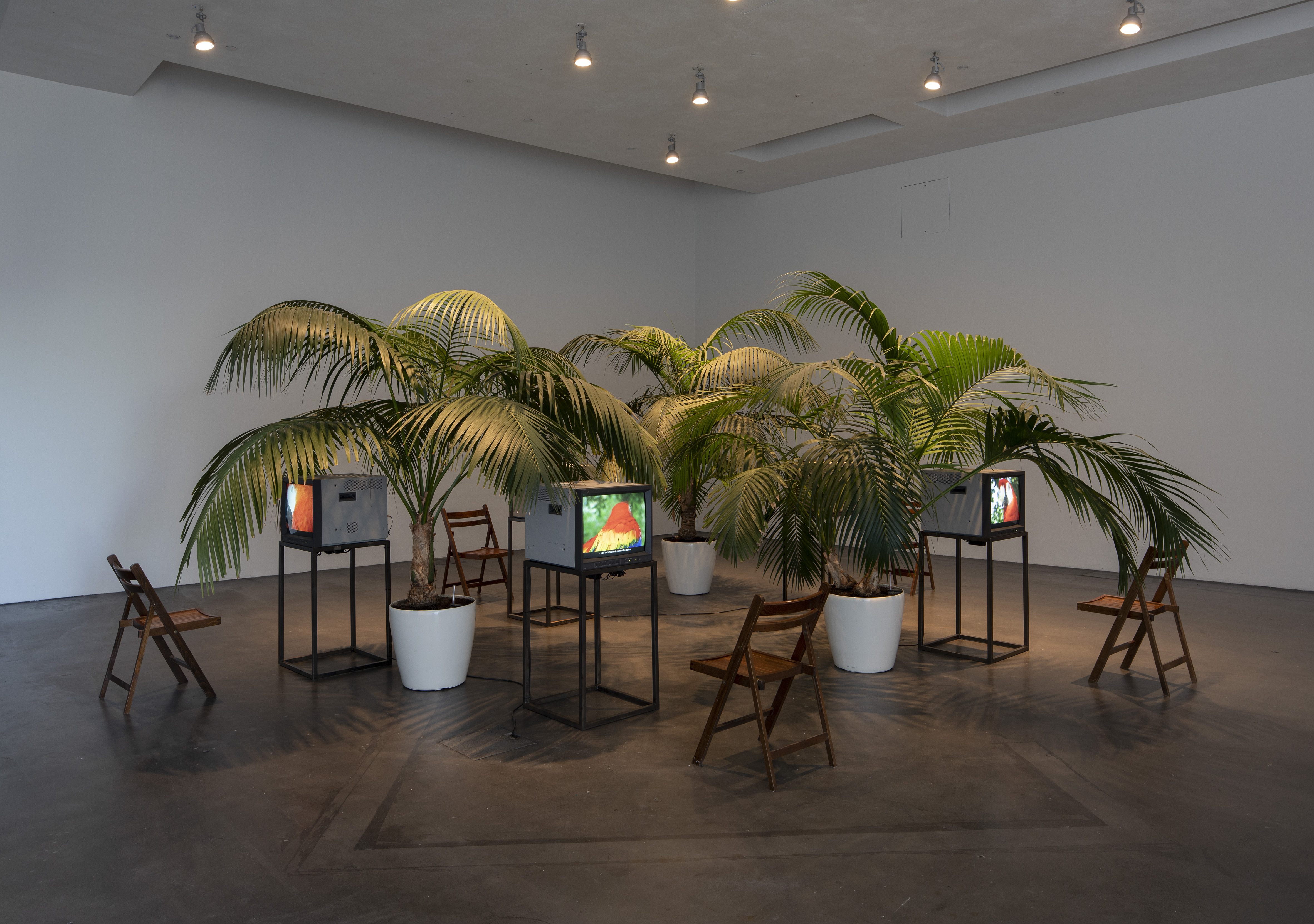
Exhibition set-up for “Genesis according to parrots”, Vega’s video work. © Finnish National Gallery / Kiasma
The labyrinthic tour of „Coexistence” in Kiasma accumulates subjective, but not less relevant, histories of colonisation, segragation, extraction and commodification, specisism and rasialisation. For example, Outi Pieski invites the viewers to regard a sculptural instalation made from threads of the Sámi traditional clothing (gákti dress). „Our Land, Our Running Colours” is an abstraction of mountain scenary in Lapland as well as a scenary of indigenous knowledge scenary, which would include „a multitude of solutions to help mankind”, according to Pieski. The work is also a political manifest as, during the worst assimilation era, from late 1800 to 1970, they were only allowed to use a white scarf – and, at this point, I cannot resist to ask myself: would we be willing, locally, to accept similar works, in terms of aesthetics and ideology, coming from our vey own assimilated and racialised community, the roma?
It’s also coloniality that informs „Immigrant Garden” a work by de Lauri Ainala & Kalle Hamm & Dzamil Kamanger. It features 26 decorative and culinary plants known to every European, yet none of them native to these lands, encompassing in their geobiology the very history of coloniality. „The human and inhuman are part of a historic discourse of settler-colonial rights and the material practices of extraction, through which rasialisation belongs to a materialcategorization into active and inert elements. Extractable matter be both passive (awaiting extraction and possessing of properties) and able to be activated through the mastery of white men – who use „sub-human” (racialised individuals) to extract the non-human (animals, plants, minerals)”[5]. The work includes illustrations of the plants (among which bassilicum, onion, rhubarb, poppy), a map of commercial routes through which they got to Finland, a book and an sound series by Hamm and Ainala in which they had recorded fluctuations in the electric conductivity field of plants[6]
What can the ecological crisis teach us on nonviolent coexistence? What kind of possibilities can we create for an interspecies justice? How can we rethink beneficial symbioses with the non-human, be it organic, unorganic or machine-generated?
Here are some questions that „Coexistence” decanted over the time and to which I prefer to answer by slightly rephrasing Vandana Shiva’s manifesto, in Earth Democracy:
„Be for the Earth and all its species. Be for the human rights of the very last person, the last child, the last human. Be for the freedom of the people, not the freedom of corporations – the corporations that destroy the planet and people’s lives, without hesitation. Be for living democracies, based on the recognition that we are members of an Earth community and have common responsibilities to protect the earth and common rights to be sustained by her, for our food and water, our lives & livelihoods. Be for the living economies in which everyone participates and no one is excluded”. [7]
–
[1] Quote from Kati Roover video work “Coexistence”, 2017
[2] Judith Butler, Capitalism Has Its Limits – https://www.versobooks.com/blogs/4603-capitalism-has-its-limits
[3] The video work is available here: https://vimeo.com/246161053
[4] Work available here: https://vimeo.com/156155494
[5] Rephrased quote from „ A Billion Black Anthropocenes or None” de Kathryn Yusoff, available here: https://manifold.umn.edu/projects/a-billion-black-anthropocenes-or-none
[6] Sound pieces available here: https://www.youtube.com/watch?v=aphm3KuGNtE&list=OLAK5uy_kOzNSe0AmNeEZRM6F4pZuef4V1frityYc
[7] Vandana Shiva, „Earth Democracy. Justice, Sustainability and Peace”, preface to the 2016 edition


